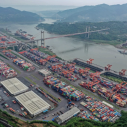Global Media, Communication Technology, and the War on Terror
archive

Global Media, Communication Technology, and the War on Terror
From the telegraph, radio, film, and television to the Internet and mobile satellite networks, media and communication technologies have been integral to the waging and representation of war. Always eager to improve communications, surveillance, and weapons systems, military institutions have funded and developed new communication technologies and media since at least the 19th century, and journalism and entertainment have long been central to governments’ propaganda efforts. In the current context of the Iraq War and the “war on terror,” most accounts of international communication equate media with news (ignoring other genres) and often neglect the crucial role that audiences and newer technologies play within wartime global media culture.
In an attempt to take advantage of the proliferation of satellite TV in Iraq previously outlawed under Saddam Hussein and widely available throughout the Middle East, the Bush administration and the Broadcasting Board of Governors (the presidentially appointed federal agency in charge of the U.S. propaganda efforts in Iraq) launched the Virginia-based satellite TV channel Alhurra (“The Free One”) in 2004 to “combat the anti-Americanism” of Arab satellite news channels, most prominently Al Jazeera and Al Arabiya. To defray the costs of Alhurra (and its Radio Sawa [“Radio Together”] counterpart), BBG chair and corporate media mogul, Norman Pattiz, drastically cut the Voice of America news staff and broadcasts in favor of a new mix of entertainment and journalism programming, confident that the entertainment would be a positive advertisement for the “American way of life” while also serving as an effective lead-in for news programming produced by the U.S. government.
From the telegraph, radio, film, and television to the Internet and mobile satellite networks, media and communication technologies have been integral to the waging and representation of war.
It has become clear that Alhurra arrived too late to matter given the already thriving pan-Arabic satellite TV market comprised of hundreds of channels that, along with the Internet, had already created a new Arab public sphere filled with contentious and passionate debate about Arab and Muslim identities, Saddam Hussein, democracy, and women’s rights. Consequently, the very naming of the channel “the free one” seems unconvincing to many Arab and Muslim viewers since the channel is completely government funded, unlike some other news sources available to pan-Arab audiences which are at least semi-independent. Thus, Alhurra has been deemed an ineffective, irrelevant, and counter-productive influence (from a U.S. standpoint) on public opinion because Arab and Muslim viewers dismiss and resist its messages as propaganda from the Bush administration. Some Muslim clerics issued written fatwas condemning the channel, and an Alhurra journalist and his son were targeted and killed by militia groups in 2005.
Although there have been cultural and religious objections to satellite TV programs across the Middle East, the popular reality program, Terrorism in the Hands of Justice, has been more politically controversial within Iraq and less visible outside of the region. Broadcast six nights a week exclusively on the state-run and U.S. financed Al Iraqiya station in Iraq, each episode consists of trembling, bruised, and humiliated militia members confessing to kidnappings and murders without a lawyer present. The program’s popularity suggests it is a successful example of U.S.
psychological operations and, similar to the long running U.S. program Cops, serves as effective propaganda for the counterinsurgent Iraqi police force. Although many Iraqis take the program as offering overwhelming evidence that insurgents are nothing more than hired hit men motivated by money and power, other Iraqis see it as a hypocritically unethical violation of basic human rights that is anathema to the principles of democracy and would not have been broadcast even under Saddam Hussein’s regime. The program has recently been the subject of a behind-the-scenes video critique that documents its vigilante techniques and lack of due process, and Human Rights Watch has condemned the program for its physical abuse and torture of suspected detainees. It has also been accused of encouraging sectarian divides by showing Shia officials interrogating and humiliating the overwhelmingly Sunni prisoners.
The ongoing war in Iraq is the first major U.S. conflict in which the technological infrastructure of the Internet age facilitated the immediate and global distribution of text, images, video and multimedia from journalists, civilians, and combatants through the Internet, Web, and mobile satellite networks. Even representations of Saddam Hussein’s execution could not be efficiently “controlled” by the Bush administration as cell phone video of the hanging was leaked and shown on television and over the Web, including YouTube, where a version has already been viewed over 2.5 million times. Most recently, in December 2007, Al Qaeda solicited interview questions for Ayman al-Zawahri using Web forums, and in January 2008, Al Qaeda’s media division, Al Sahab, announced that its first batch of cell phone videos (always subtitled in English) were ready for downloading. YouTube.com and other Web sites distribute thousands of amateur videos from inside Iraq documenting civilian casualties, war crimes, corruption, and atrocities. Insurgent propaganda messages and videos of the murder of Western hostages by militia groups are readily available on the Web and over file sharing networks, as are videos from U.S. helicopter cockpits showing the killing of Iraqis (including the pilots’ reactions) along with daily translations of broadcasts from the major pan-Arab TV networks.
It would thus be difficult to exaggerate the degree to which the existence of the Internet has complicated the U.S. government’s efforts to manage information within and outside the “theater of operations.” Indeed, the preference of the current Bush administration would no doubt have been to try to absent all images of suffering and death that have resulted from the 2003 Iraq War as was done during the 1991 Gulf War (with rare exceptions). In response to this new global communications environment, the Pentagon has implementing electronic warfare (EW) strategies outlined in the recently declassified Information Operations Roadmap commissioned and approved by Donald Rumsfeld in 2003. Approaching the Internet as an enemy “weapons system,” the Roadmap’s goal is to “[p]rovide a future EW capability sufficient to provide maximum control of the entire electromagnetic spectrum, denying, degrading, disrupting, or destroying the full spectrum of globally emerging communication systems, sensors, and weapons systems dependant on the electromagnetic spectrum.” A major focus in this regard is the ability to disable cell phones, which at times have been presented by the Pentagon and journalists as a sign of “progress” in Iraq, but are also commonly used as efficient remote detonators for roadside bombs (or IEDs), which can also be activated through Internet messaging applications. The Roadmap also calls for "improvements in PSYOP capability . . . to rapidly generate audience specific, commercial-quality products into denied areas" and “project . . . electronic attacks into denied areas by means of stealthy platforms." One might conclude that the ultimate goal of the global information war on terror is to remove or control all non-U.S. communication and news from the designated regions.
It would thus be difficult to exaggerate the degree to which the existence of the Internet has complicated the U.S. government’s efforts to manage information within and outside the “theater of operations.”
This brief overview suggests that we should not assume an outdated and reductive model of media imperialism or technological determinism toward an examination of global media, technology and war, since – the Information Operations Roadmap notwithstanding – a wide range of messages are being actively created and resisted in the Middle East, and technologies like the cell phone and the Internet are being put to a variety of uses from the beneficent (calling in suspected IEDs) to the violent (detonating them). Through a broad range and complex mixture of transnational and regional media –along with new technologies of distribution – there are consistent representations of the “American way of life” in addition to war images and information from all sides.



